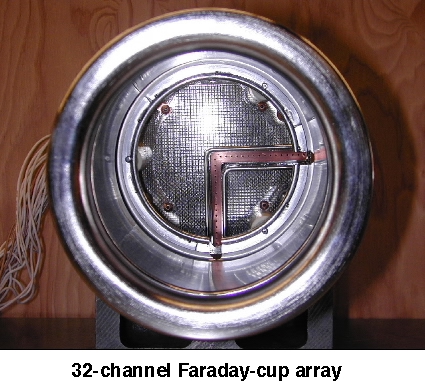Beam
Diagnostics
- Diagnostic instruments are essential for
monitoring and assessing any beam experiment.
These diagnostics provide information on the state of
the beam and on the progress and results of
experiments performed on the beam, monitoring
critical beam parameters such as current, size,
energy, and emittance. A number of beam diagnostics
are currently in use in the HIF program:
- Rogowski coils to measure time-dependent net beam
current
- Faraday cups to measure intercepted beam
current
- Profile monitors, such as Kapton film and optical
imaging on glass screens, harps, and grids, to
measure beam profiles and spatial distributions
- Capacitive probes to infer time-dependent moments
of the transverse beam distribution
- Gated beam imager to measure time-dependent beam
distribution
- Emittance scanner to measure the transverse beam
emittance
 A 32-channel Faraday
cup array, shown here, is used to map the radial beam
profile of the 2-MV Injector. This and other devices
will be used to diagnose the High-Current
Experiment (HCX), which will have a beam current
similar to that expected in the front end of a
driver. A 32-channel Faraday
cup array, shown here, is used to map the radial beam
profile of the 2-MV Injector. This and other devices
will be used to diagnose the High-Current
Experiment (HCX), which will have a beam current
similar to that expected in the front end of a
driver.
Recently, scientists have begun evaluating whether
free electrons in a fusion driver would be trapped by
the beam space charge and degrade the performance of
the accelerator. Free electrons can be produced in
induction accelerators by two mechanisms: collisions of
halo ions or free electrons with the beam-pipe wall,
and collisional ionization by beam ions of background
gas in the accelerator. Due to the high current
possible in induction accelerators, the beam potential
can be thousands of volts and is expected to trap most
free electrons created within the beam. Several new
diagnostics have been proposed for HCX to measure
the generation and trapping of electrons, and the
production of secondary particles at the wall:
- Instrumented target to measure gas evolution and
secondary electron production
- Gridded ion-energy analyzer to measure energy of
background ions expelled from the beam
- Low-frequency interferometer to measure trapped
electron density
In new and planned experiments, such as the Neutralized-Transport
Experiment (NTX) and the Integrated Beam
Experiment (IBX), further diagnostic development
will be required to monitor additional beam
characteristics:.
- Beam-energy spectrometer to measure the time
evolution of the beam energy and beam-energy
distribution. This device may be a time-of-flight
spectrometer or a magnetic spectrometer.
- Electron-beam probe to measure space-charge
potential at final focus of NTX. The potential is
measured by monitoring the electric-field-induced
deflection of an electron beam injected across the
path of the heavy-ion beam.
Beams in HIF experiments to date have had sufficiently
low current and energy that diagnostic devices could be
inserted into the beam without damaging the apparatus
or producing unwanted x-rays. In the future, as beam
energies increase, a growing interest in
non-intercepting diagnostics is expected. These
diagnostics might be optically based and depend on
remote sensing of interaction between beam ions and
residual gas or an injected gas jet. An active
diagnostic device of this sort might also be based on
laser-induced fluorescence. Such a device would use an
intense short-pulse laser to excite beam ions. The
light emitted by these ions as they return to their
ground state could be used to determine the local beam
density and emittance. The main drawbacks of this
device are its projected cost and the problem of
finding a good match between available laser
frequencies and excited states in a beam ion.
-


For comments or questions contact
WMSharp@lbl.gov
or DPGrote@lbl.gov.
Work described here was supported by the Office of
Fusion Energy at the US Department of Energy under
contracts DE-AC03-76SF00098 and
W-7405-ENG-48. This document was last revised
June, 2002.
|
 A 32-channel Faraday
cup array, shown here, is used to map the radial beam
profile of the 2-MV Injector. This and other devices
will be used to diagnose the High-Current
Experiment (HCX), which will have a beam current
similar to that expected in the front end of a
driver.
A 32-channel Faraday
cup array, shown here, is used to map the radial beam
profile of the 2-MV Injector. This and other devices
will be used to diagnose the High-Current
Experiment (HCX), which will have a beam current
similar to that expected in the front end of a
driver.
